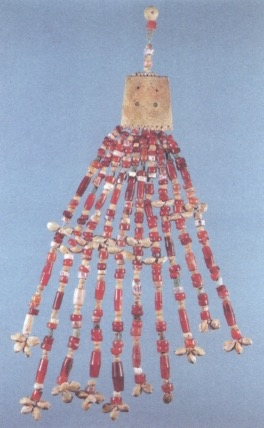| Carnelian in China | |||||
| Re: PEME RIKA'S -- odan | Post Reply | Edit | Forum | Where am I? | |
04/28/2018, 22:59:22
He is completely wrong about the history of carnelian in Chinese adornment. There is a massive amount of archaeological evidence published in China and elsewhere to show that carnelian was a highly valued material long, long before the introduction of coral in any substantial quantity. You can see carnelian beads displayed in just about every museum in China, and throughout Southeast Asia also. It was introduced from Central Asia as early as the Shang dynasty (and probably before) and in the Zhou dynasty (1046-256 BCE) it was of great importance in the composition of elaborate court necklaces - an indispensable accompaniment to jade, which has of course been the most treasured material of all in China from the earliest times.
I’ll attach a photo that comes from a Chinese archaeology journal; it’s not very clear I’m afraid, but it shows a trapezoidal carved jade panel with dangles of carnelian and shell beads. It comes from a royal tomb in what is now Shanxi province and dates to the 10th century BCE. Many excavated necklaces and bracelets were a lot more complex in design than this one but similar in the integration of carnelian beads with jade.The carnelians are tubular, oblate and bi-conical. It appears that darker red stone (pema raka-ish)was more highly valued than the orangey, more translucent variety. Many of the beads found from this period were made in Central or West Asia, but some appear to have been locally carved from imported stone, and by the mid-Zhou dynasty Chinese agate was being mined for carnelian production. There seems to have been much less interest in the production of blackened agate than there was in Southeast Asia somewhat later.
Jessica Rawson, who used to be Keeper of the Department of Oriental Antiquities at the British Museum, has a very good article about Chinese carnelian in Cahiers d’Extrème Orient, vol. 17 (2008). She describes seeing “heaps” of carnelian at exacavated Zhou burial sites, and makes an important point in her insistence on the way in which jade and carnelian were frequently combined in court jewellery, which tends to be forgotten by people like myself who collect early jades and make the mistake of seeing them in isolation.
This popularity of carnelian never really waned in China, though probably its easy availability might have made it less treasured in some periods than in others. Jamey is completely right in saying that pema raka beads are simply a continuing symptom of that fashion for red stone and that coral only came into the picture in a substantial way much later. Coral had the attraction of being exotic, but even in the Qing dynasty carnelian continued to be widely used at the Manchu court.
Best,
Will

All rights reserved by Bead Collector Network and its users
|